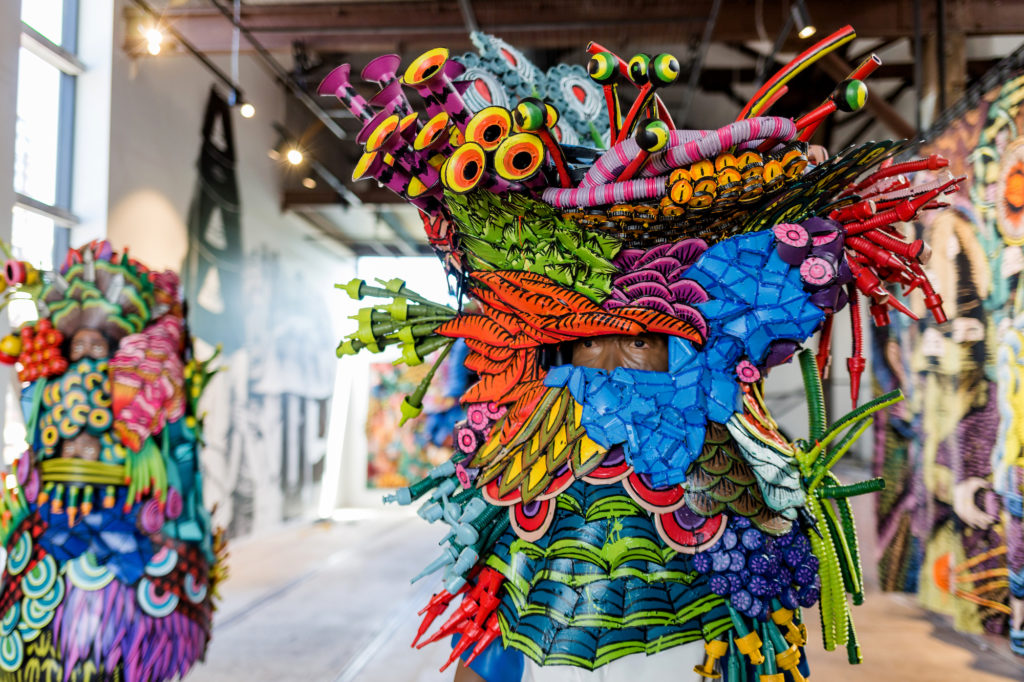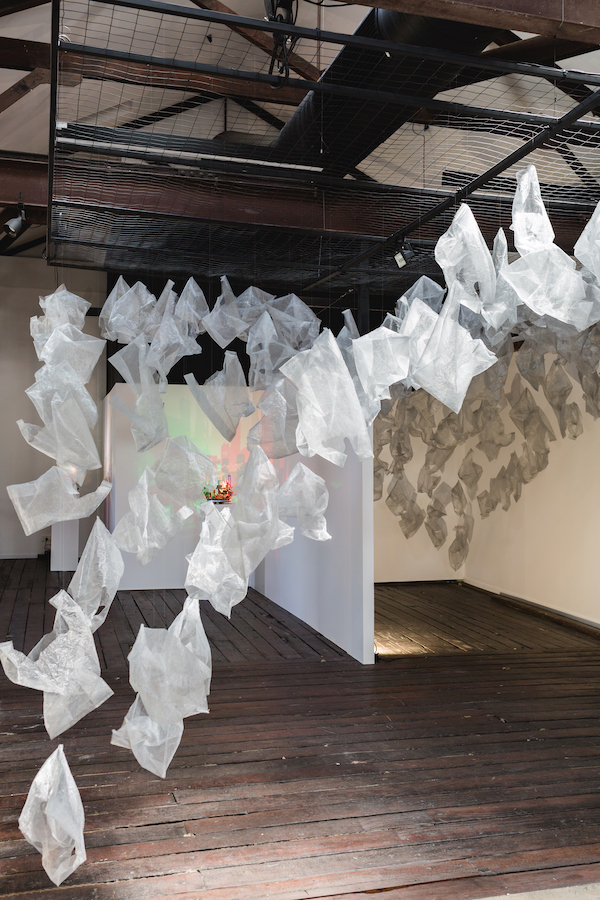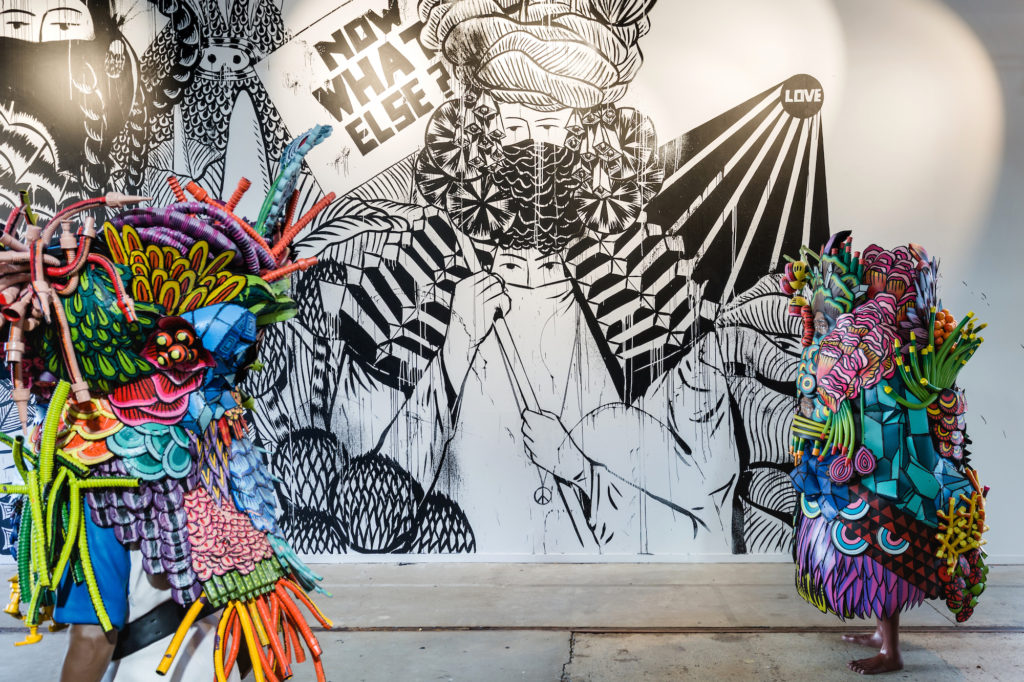Amidst the vibrant colours and varied textures of FORM’s ‘Plasticology’ exhibition, three artists highlight the need to rethink our approach to the global plastic emergency, writes Belinda Hermawan.
Plastic recycled and reimagined
8 April 2020
- Reading time • 6 minutesVisual Art
More like this
- A walk with Tina Stefanou
- A blaze of glorious people
- Diving into the gothic world of Erin Coates
“Plasticology”, Eko Nugroho, Angela Yuen and Yu Fang Chi ·
FORM, The Goods Shed Claremont, 19 March 2020 ·
Review by Belinda Hermawan ·
FORM’s latest exhibition at The Goods Shed is a thought-provoking showcase of artistic responses to plastic and pollution. Despite only being invented around 100 years ago, plastic’s low production cost, mouldability and durability have guaranteed its place in our everyday lives. This permanence, however, exists in another sense: the majority of plastics aren’t biodegradable and only nine percent is recycled worldwide.
Eko Nugroho (Indonesia) has innovatively reused plastic items to create elaborate masks that warrant viewing from all angles. The sculptural work in Future Fungus #1, Over Reality and Future Fungus #2 is painted in bold, vibrant colours, with the waste items almost unrecognisable at first glance: bottles, lids, hoses, pipes, soap pumps, containers, golf balls.

Yet the striking visual effect is more than the initial impression of the tropical and exotic. Masks demand a wearer, and two of these sit on mannequins while one hangs suspended. The man in Future Fungus #1 holds an overnight bag in one hand and a bouquet of Australian natives in the other – is he coming or going, congratulating or mourning? Though Australasia is increasingly connected, this work suggests that disconnect still exists. Viewing Future Fungus #1 I couldn’t help but reflect that collaboration and exchange should go beyond shipping our recycling and garbage to another country.
Faces peek out of forests in the wall hangings Nothing’s Going to Change the World and Slurping Pandora Broth, their mouths covered. Contrast this to the everyday Australians depicted in the painted, monochrome wall mural who, while faceless under the body of a parasitic-like bug, nonetheless line up behind the masked leader as if to “Follow, follow, follow, follow” (to quote one of their t-shirts). It all begs the question of who is paying attention, who is being heard and who has the power to enact change.
It all begs the question of who is paying attention, who is being heard and who has the power to enact change.

Yu Fang Chi (Taiwan/Australia) creates a subtle but mesmerising sense of movement in her installation work Remnant, which embraces the motif of the plastic bag to meditate on our environment, the passage of time and the act of manufacture. Silvery nylon bags are individually hung, able to rotate, spin and sway on their own while collectively being part of an asymmetrical arc that mimics a sweeping gust of wind. We have all witnessed the flight of a discarded plastic bag – it was even romanticised in the 1999 film American Beauty – yet it is important to remember the challenge posed by this material. The shadows created by the bags on the blank wall are a powerful reminder of their multitude, eerily duplicating in form and in motion.
Two highly original works from Angela Yuen (Hong Kong) take rudimentary plastic objects and trinkets and elevate them into emotionally resonant carousels of light and wonder. For The Stranger III, Yuen collected odds and ends from her local community to construct a miniature city on a halved plastic orb. She then discovered backlighting the sculpture created a shadow play. Utilising LED lights and motors, a nostalgic Hong Kong cityscape comes to life from the shadows of pill boxes, rulers and stationery, hair rollers, novelties and toy cars. The Puzzle I (pictured top) moves away from nostalgia and into alarm: stark green and red illumination pairs with dizzying movement on two axes. In the ups and downs of Hong Kong life, an underground is visible under the skyscrapers, plastic toys transformed into hanging human shadows. Look closely at both installations and you’ll spot the police presence.
In successfully up-cycling synthetic materials, the featured artists highlight the need to rethink our approach to this environmental emergency. I highly recommend visiting the exhibition when it is able to reopen later this year.
A message from FORM: Due to the outbreak of COVID-19, and for the health and safety of our audiences, FORM have taken the decision to close our exhibition space, The Goods Shed, for the time being. We hope to reopen later this year, once it it safe to do so. In the meantime, look after yourselves, and please check for updates at thegoodsshedclaremont.com We hope to be back once the current health situation is resolved.
Pictured top: ‘The Puzzle I’, Angela Yuen, 2020, plastic toys, motors, LED lights, resin, perspex, beads, Dia 40 x H30cm. Photo: Taryn Hays, Courtesy of FORM.

Like what you're reading? Support Seesaw.






